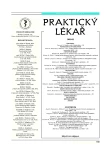Benign cutaneous pigmented lesions and the various possibilities in their examination
Authors:
K. Pizinger; T. Fikrle
Authors‘ workplace:
Dermatovenerologická klinika LF UK a FN, Plzeň
přednosta prof. MUDr. V. Resl, CSc.
Published in:
Prakt. Lék. 2005; 85(4): 202-206
Category:
Of different specialties
Overview
Melanocytic cutaneous neoplasms could be basically divided into benign and malignant lesions. The former are melanotic spots (freckles, lentigo, etc. which are caused by hyperfunction and hyperplasia of melanocytes), and melanocytic nevi (congenital, common acquired, Spitz, blue nevi, etc. which are hamartomas and benign tumours). The latter are malignant melanomas. We give notice of nonmelanocytic lesions in the differential diagnosis of melanoma. The clinical examination by experienced dermatologists is still the basic diagnostic method in patients with pigmented skin lesions. Dermatoscopy is a noninvasive second-step procedure which increases the diagnostic certainity in difficult cases and reduces the number of needless surgical excisions. The digital version of dermatoscopy makes the high-quality follow-up of patients with multiple or atypical melanocytic lesions posssible, it also enables the comparison of actual dermatoscopic images with other lesions from a database or atlas. Digital analysis of dermatoscopic images provides objective information about the geometric, structural and color characteristics of the lesion. The results of digital analysis cannot replace the clinical examination of patients with melanocytic lesions. We describe the basic recommendations for the examination of patients with pigmented skin lesions.
Key words:
melanocyte – melanocytic lesions – differential diagnosis – dermatoscopy – digital dermatoscopy.
Labels
General practitioner for children and adolescents General practitioner for adultsArticle was published in
General Practitioner

2005 Issue 4
Most read in this issue
- The aggressive patient
- Benign cutaneous pigmented lesions and the various possibilities in their examination
- Genetics and ethics – past, present, and future
- Musculoskeletal complaints at work with the computer
